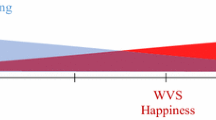Abstract
Houston Environmental Foresight, an urban region comparative risk assessment, demonstrated the importance of process as well as analytic methodology. These features are best illustrated in the work of its Socioeconomic Subpanel, which assessed environmental risks to economic well-being and quality of life. Several issues are raised by the process and methods used by the subpanel. Some of these issues could be addressed through national research on comparative risk methods; other issues are most likely to be addressed through the incremental improvements of future projects.
Similar content being viewed by others
References
Andrews, R.N.L. (1995) Toward the 21st Century: Planning for the Protection of California's Environment. California Comparative Risk Project Reviewed. Environment 37, May 1995.
CCRP (1994) Toward the 21st Century: Planning for the Protection of California's Environment. California Comparative Risk Project (CCRP), Office of Environmental Health Hazard Assessment, California Environmental Protection Agency, Sacramento, CA.
Davies, J.C. (1996) Comparing Environmental Risks. Resources for the Future, Washington, DC.
Delhagen, E. and Dea, J. (1996) Comparative Risk at the Local Level: Lessons from the Road. Western Center for Environmental Decision-Making, Boulder, CO. Available at http://www.gmied.org/.
Ding, C.G., Woo, Y.Y., Sheu, H., Chien, H. and Shen, S. (1996) An effective statistical approach for comparative risk assessment. Risk Analysis 16, 411–419.
Environ (1988) Elements of Toxicology and Chemical Risk Assessment. Environ Corporation, Arlington, VA.
EPA (1987) Unfinished Business: A Comparative Assessment of Environmental Problems. U.S. Environmental Protection Agency (EPA), Office of Policy Analysis, Office of Policy, Planning and Evaluation, Washington, DC.
EPA (1990) Reducing Risk: Setting Priorities and Strategies for Environmental Protection. U.S. Environmental Protection Agency (EPA) Science Advisory Board SAB-EC-90–021, Washington, DC.
Finkel, A.M. (1996) Comparing risks thoughtfully. Risk: Health Safety and Environment 7, 325–359.
Foresight Committee (1996) Seeking Environmental Improvement. Houston Advanced Research Center, The Woodlands, TX. Available at http://www.harc.edu/4site/.
Foresight Science Panel (1996) Houston Environment 1995. Houston Advanced Research Center, TheWoodlands, TX. Available at http://www.harc.edu/4site/.
Kahn, J.R. (1998) The Economic Approach to Environmental and Natural Resources. Harcourt Brace, Orlando, FL.
McCreary, S. and Gamman, J. (1992) Mediating a Statewide Environmental Dialogue in Louisiana. Concur Working Paper 92-01, Concur, Berkeley and Santa Cruz, CA.
Michalowski, R., Solop, F. and Trotter, R. (1995) Public Values Assessment. Arizona Comparative Environmental Risk Project, Arizona Department of Environmental Quality, Phoenix, AZ.
NCCR(1992) Analytical Criteria: Background Documents. Northeast Center for Comparative Risk (NCCR) No. 5, Vermont Law School, South Royalton, VT. (NCCR is now the Green Mountain Institute for Environmental Democracy located in Montpelier, Vermont. The paper is available at their web site http://www.gmied.org/.
Rosenbaum, W.A. (1990) More choices: risk assessment. In Environmental Politics and Policy. 2d ed. Congressional Quarterly Press, Washington, DC.
Serageldin, I. and Steer, A. (1994) Making Development Sustainable: From Concepts to Action. Environmentally Sustainable Development Occasional Paper Series No. 2, The World Bank, Washington, DC.
State of Washington (1989a) The State of the Environment Report. Draft Economic Damages Risk Evaluation Reports, Volume I, Washington Environment 2010, Olympia, WA.
State of Washington (1989b) The State of the Environment Report. Draft Economic Damages Risk Evaluation Reports, Volume III, Appendix A, Washington Environment 2010, Olympia, WA.
SVTC (1991) Environment 1991: Risks to Vermont and Vermonters. Strategy forVermont's Third Century (SVTC). Vermont Agency of Natural Resources, Waterbury, VT.
TNRCC (1997) State of Texas Environmental Priorities Project. Texas Natural Resource Conservation Commission, Austin, TX.
Thompson, R., Templet, P.H., Gamman, J.K., McCleary, S.T. and Reams, M.A. (1994) A Process for Incorporating Comparative Risk into Environmental Policymaking in Louisiana. Risk Analysis 14, 857–861.
Voogd, H. (1983) Multicriteria Evaluation for Urban and Regional Planning. Pion Limited, London.
Author information
Authors and Affiliations
Rights and permissions
About this article
Cite this article
Wilson, J.D., Kohlhase, J.E. & Strawn, S. Quality of life and comparative risk in Houston. Urban Ecosystems 3, 113–129 (1999). https://doi.org/10.1023/A:1009575813596
Issue Date:
DOI: https://doi.org/10.1023/A:1009575813596




